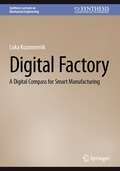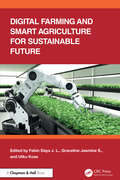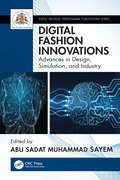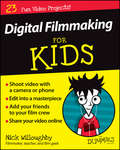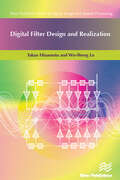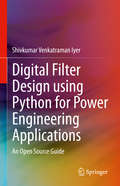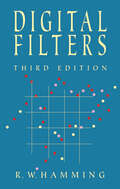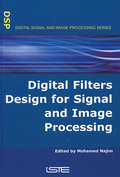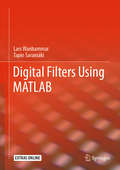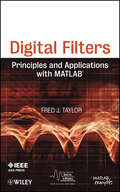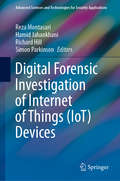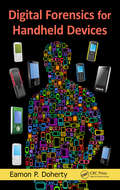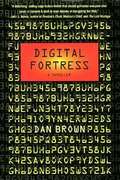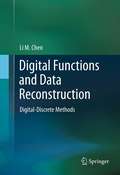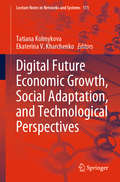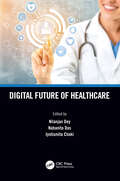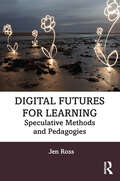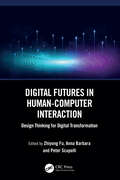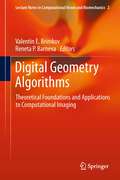- Table View
- List View
Digital Factory for Human-oriented Production Systems
by Myrna Flores Claudia Redaelli Luca CanettaDigital factory is a comprehensive approach providing methodologies, models and tools that support manufacturing enterprises in the rearrangement of their organizational structures to deal with expected changes in manufacturing processes and markets. Digital Factory for Human-oriented Production Systems investigates the impact of the digital factory through a consideration of the entire product/process lifecycle, and the broad network of product engineering, material and component suppliers, manufacturing equipment suppliers, and customers involved in current and next generation manufacturing. It covers the utilization and integration of: human body ergonomics models;production system discrete event simulation;3D/virtual and augmented reality visualization;collaborative design tools;automatic data capture; andknowledge management systems based on semantic web ontologies integrated by a continuous data management.The coverage of various types of factory and manufacturing phases, representations and simulations allows researchers in academia and industry to perform a dynamic analysis and up-to-date modeling of the processes involved. Digital Factory for Human-oriented Production Systems describes the tools that allow a move towards the integrated digital factory and underlines the business impact that companies can obtain by adopting these tools. As well as benefiting international organizations, the proposed methodologies and technologies have also been developed in order to facilitate their adoption by small or medium-sized businesses, making them relevant to all product engineers and managers who want improve the efficiency and effectiveness of their enterprises.
Digital Factory: A Digital Compass for Smart Manufacturing (Synthesis Lectures on Mechanical Engineering)
by Luka KozamernikThe Digital Factory is a comprehensive guide for leaders in the manufacturing sector looking to navigate the complex digital transformation landscape. Digitalization has become crucial to any company's success in today's fast-paced business world. However, making sense of the plethora of information on approaching digitalization can be challenging, leaving many leaders needing clarification. The pressure to make the right decisions can be overwhelming, with various groups advocating their interests. Without a clear vision and understanding of digital transformation, leaders may lack confidence in making the right company decisions. And with access to specific and valuable knowledge about digital transformation, achieving optimal returns for the company can be more accessible. This book is designed to empower leaders in the manufacturing sector to overcome these challenges.
Digital Farming and Smart Agriculture for Sustainable Future
by Utku Kose J. L Febin Daya S. Graceline JasmineThis book presents the impact and scope of Internet of Things (IoT), Artificial Intelligence (AI), and Machine Learning (ML) in the growth of intelligent digital farming and smart agriculture. It offers insights into advanced analytics, prognostics capabilities, and the development of economic models for creating innovative software applications and tools necessary for developing IoT devices for precision agriculture. It explores the latest advancements in these fields and their applications, gaining valuable insights into the future of digital farming. The case studies and exploration of future implications make it an excellent guide for academicians and researchers in this field. Discusses various aspects of AI-driven demand forecasting and management Covers smart IoT framework for precision agriculture Includes topics related to deep learning techniques combined with IoT for smart agriculture Explores the scope of computer vision technologies aid in precise crop management Highlights the potential of energy optimization and environmental sustain- ability in agricultural practices This reference book serves as a valuable resource for researchers and graduates in the fields of tеchnology-driven revolution in agriculture.
Digital Fashion Innovations: Advances in Design, Simulation, and Industry (Textile Institute Professional Publications)
by Abu Sadat Muhammad SayemDigitalisation is becoming a standard practice in the fashion industry. Innovation in digital fashion is not just limited to computer-aided design (CAD) and manufacturing (CAM), rather it runs throughout the fashion supply chain, from product life cycle management and developing new business models that promote sustainability to connecting virtual and augmenting reality (VR/AR) with fashion for enhanced consumers experience through smart solutions. Digital Fashion Innovations: Advances in Design, Simulation, and Industry captures the state-of-art developments taking place in this multi-disciplinary field: Discusses digital fashion design and e-prototyping, including 2D/3D CAD, digital pattern cutting, virtual drape simulation and fit analysis. Covers digital human modelling and VR/AR technology. Details digital fashion business and promotion, including application of e-tools for supply chain, e-commerce, block chain technologies, big data, and artificial intelligence (AI). This interdisciplinary book will appeal to professionals working in textile and fashion technology, those developing AR and AI for clothing end uses, and anyone interested in the business of digital fashion and textile design. It will also be of interest to scientists and engineers working in anthropometry for a variety of disciplines, such as medical devices and ergonomics.
Digital Filmmaking For Kids For Dummies
by Nick WilloughbyThe easy way for kids to get started with filmmaking If you've been bitten by the filmmaking bug--even if you don't have a background in video or access to fancy equipment--Digital Filmmaking For Kids makes it easy to get up and running with digital filmmaking! This fun and friendly guide walks you through a ton of cool projects that introduce you to all stages of filmmaking. Packed with full-color photos, easy-to-follow instruction, and simple examples, it shows you how to write a script, create a storyboard, pick a set, light a scene, master top-quality sound, frame and shoot, edit, add special effects, and share your finished product with friends or a global audience. Anyone can take a selfie or upload a silly video to YouTube--but it takes practice and skill to shoot professional-looking frames and make your own short film. Written by a film and video professional who has taught hundreds of students, this kid-accessible guide provides you with hands-on projects that make it fun to learn all aspects of video production, from planning to scripting to filming to editing. Plus, it includes access to videos that highlight and demonstrate skills covered in the book, making learning even easier and less intimidating to grasp. Create a film using the tools at hand Plan, script, light and shoot your video Edit and share your film Plan a video project from start to finish If you're a student aged 7-16 with an interest in creating and sharing your self-made video, this friendly guide lights the way for your start in digital filmmaking.
Digital Filter Design and Realization
by Wu-Sheng Lu Takao HinamotoAnalysis, design, and realization of digital filters have experienced major developments since the 1970s, and have now become an integral part of the theory and practice in the field of contemporary digital signal processing. Digital Filter Design and Realization is written to present an up-to-date and comprehensive account of the analysis, design, and realization of digital filters. It is intended to be used as a text for graduate students as well as a reference book for practitioners in the field. Prerequisites for this book include basic knowledge of calculus, linear algebra, signal analysis, and linear system theory. Technical topics discussed in the book include:Discrete-Time Systems and z-TransformationStability and Coefficient SensitivityState-Space ModelsFIR Digital Filter DesignFrequency-Domain Digital Filter DesignTime-Domain Digital Filter DesignInterpolated and Frequency-Response-Masking FIR Digital Filter DesignComposite Digital Filter DesignFinite Word Length EffectsCoefficient Sensitivity Analysis and MinimizationError Spectrum ShapingRoundoff Noise Analysis and MinimizationGeneralized Transposed Direct-Form IIBlock-State Realization
Digital Filter Design using Python for Power Engineering Applications: An Open Source Guide
by Shivkumar Venkatraman IyerThis book is an in-depth description on how to design digital filters. The presentation is geared for practicing engineers, using open source computational tools, while incorporating fundamental signal processing theory. The author includes theory as-needed, with an emphasis on translating to practical application. The book describes tools in detail that can be used for filter design, along with the steps needed to automate the entire process.Breaks down signal processing theory into simple, understandable language for practicing engineers;Provides readers with a highly-practical introduction to digital filter design;Uses open source computational tools, while incorporating fundamental signal processing theory;Describes examples of digital systems in engineering and a description of how they are implemented in practice;Includes case studies where filter design is described in depth from inception to final implementation.
Digital Filters (Dover Civil and Mechanical Engineering)
by Richard W. HammingDigital signals occur in an increasing number of applications: in telephone communications; in radio, television, and stereo sound systems; and in spacecraft transmissions, to name just a few. This introductory text examines digital filtering, the processes of smoothing, predicting, differentiating, integrating, and separating signals, as well as the removal of noise from a signal. The processes bear particular relevance to computer applications, one of the focuses of this book.Readers will find Hamming's analysis accessible and engaging, in recognition of the fact that many people with the strongest need for an understanding of digital filtering do not have a strong background in mathematics or electrical engineering. Thus, this book assumes only a knowledge of calculus and a smattering of statistics (reviewed in the text). Adopting the simplest, most direct mathematical tools, the author concentrates on linear signal processing; the main exceptions are the examination of round-off effects and a brief mention of Kalman filters. This updated edition includes more material on the z-transform as well as additional examples and exercises for further reinforcement of each chapter's content. The result is an accessible, highly useful resource for the broad range of people working in the field of digital signal processing.
Digital Filters Design for Signal and Image Processing (Digital Signal And Image Processing Ser.)
by Mohamed NajimDealing with digital filtering methods for 1-D and 2-D signals, this book provides the theoretical background in signal processing, covering topics such as the z-transform, Shannon sampling theorem and fast Fourier transform. An entire chapter is devoted to the design of time-continuous filters which provides a useful preliminary step for analog-to-digital filter conversion. Attention is also given to the main methods of designing finite impulse response (FIR) and infinite impulse response (IIR) filters. Bi-dimensional digital filtering (image filtering) is investigated and a study on stability analysis, a very useful tool when implementing IIR filters, is also carried out. As such, it will provide a practical and useful guide to those engaged in signal processing.
Digital Filters Using MATLAB
by Lars Wanhammar Tapio SaramäkiThis textbook provides comprehensive coverage for courses in the basics of design and implementation of digital filters. The book assumes only basic knowledge in digital signal processing and covers state-of-the-art methods for digital filter design and provides a simple route for the readers to design their own filters. The advanced mathematics that is required for the filter design is minimized by providing an extensive MATLAB toolbox with over 300 files. The book presents over 200 design examples with MATLAB code and over 300 problems to be solved by the reader. The students can design and modify the code for their use. The book and the design examples cover almost all known design methods of frequency-selective digital filters as well as some of the authors’ own, unique techniques.
Digital Filters: Principles and Applications with MATLAB (IEEE Series on Digital & Mobile Communication)
by Fred TaylorThe book is not an exposition on digital signal processing (DSP) but rather a treatise on digital filters. The material and coverage is comprehensive, presented in a consistent that first develops topics and subtopics in terms it their purpose, relationship to other core ideas, theoretical and conceptual framework, and finally instruction in the implementation of digital filter devices. Each major study is supported by Matlab-enabled activities and examples, with each Chapter culminating in a comprehensive design case study.
Digital Food: From Paddock to Platform (Contemporary Food Studies: Economy, Culture and Politics)
by Tania LewisThe author offers the first critical account of the impact of digital information, media, and communication technologies on food. She critically analyzes how our relationship to food consumption, production, and politics is being re-mediated through digitally connected electronic devices, practices, and content. By drawing together, the world of food and the digital, the book speaks to a number of pressing contemporary themes including the tensions around digital engagement in increasingly commercialized spaces; the changing nature of politics in a social media context; the growing naturalization of digital devices and related practices of data monitoring; and the role and impact of digitization on social relations. At the forefront of critical new research, and written with a student readership in mind, this text is essential for scholars interested in media studies, cultural studies, food studies, and cultural geography.
Digital Forensic Investigation of Internet of Things (Advanced Sciences and Technologies for Security Applications)
by Richard Hill Hamid Jahankhani Simon Parkinson Reza MontasariThis book provides a valuable reference for digital forensics practitioners and cyber security experts operating in various fields of law enforcement, incident response and commerce. It is also aimed at researchers seeking to obtain a more profound knowledge of Digital Forensics and Cybercrime. Furthermore, the book is an exceptional advanced text for PhD and Master degree programmes in Digital Forensics and Cyber Security. Each chapter of this book is written by an internationally-renowned expert who has extensive experience in law enforcement, industry and academia. The increasing popularity in the use of IoT devices for criminal activities means that there is a maturing discipline and industry around IoT forensics. As technology becomes cheaper and easier to deploy in an increased number of discrete, everyday objects, scope for the automated creation of personalised digital footprints becomes greater. Devices which are presently included within the Internet of Things (IoT) umbrella have a massive potential to enable and shape the way that humans interact and achieve objectives. These also forge a trail of data that can be used to triangulate and identify individuals and their actions. As such, interest and developments in autonomous vehicles, unmanned drones and ‘smart’ home appliances are creating unprecedented opportunities for the research communities to investigate the production and evaluation of evidence through the discipline of digital forensics.
Digital Forensics Explained
by Greg GogolinThis book covers the full life cycle of conducting a mobile and computer digital forensic examination, including planning and performing an investigation as well as report writing and testifying. Case reviews in corporate, civil, and criminal situations are also described from both prosecution and defense perspectives. Digital Forensics Explained, Second Edition draws from years of experience in local, state, federal, and international environments and highlights the challenges inherent in deficient cyber security practices. Topics include the importance of following the scientific method and verification, legal and ethical issues, planning an investigation (including tools and techniques), incident response, case project management and authorization, social media and internet, cloud, anti-forensics, link and visual analysis, and psychological considerations. The book is a valuable resource for the academic environment, law enforcement, those in the legal profession, and those working in the cyber security field. Case reviews include cyber security breaches, anti-forensic challenges, child exploitation, and social media investigations. Greg Gogolin, PhD, CISSP, is a Professor of Information Security and Intelligence at Ferris State University and a licensed Professional Investigator. He has worked more than 100 cases in criminal, civil, and corporate environments.
Digital Forensics for Handheld Devices
by Eamon P. DohertyApproximately 80 percent of the worlds population now owns a cell phone, which can hold evidence or contain logs about communications concerning a crime. Cameras, PDAs, and GPS devices can also contain information related to corporate policy infractions and crimes. Aimed to prepare investigators in the public and private sectors, Digital Forensics
Digital Forensics in Next-Generation Internet of Medical Things: Balancing Security and Sustainability
by Mariya Ouaissa Mariyam Ouaissa Sita Rani Hemant Kumar Saini Hajar Moudoud El Houda, Zakaria AbouThis book provides a comprehensive exploration of the security challenges and solutions with digital sustainability in the rapidly evolving digital landscape of digital forensics. It explores the details of protecting Internet of Medical Things (IoMT) environments, where the medical data, patient data, and machine data are at high risk with the digital experiences. The book seeks to provide researchers, medical practitioners, and IT specialists with important information. It aims to set the stage for a future in which security and efficiency in IoMT smoothly blend through real-world case studies. Key themes cover IoMT-specific forensic techniques, the difficulties of striking a balance between environmental responsibility and security, and creative solutions that combine the two viewpoints.
Digital Fortress-
by Dan BrownBefore the multi-million, runaway bestseller The Da Vinci Code, Dan Brown set his razor-sharp research and storytelling skills on the most powerful intelligence organization on earth--the National Security Agency (NSA), an ultra-secret, multibillion-dollar agency many times more powerful than the CIA. When the NSA's invincible code-breaking machine encounters a mysterious code it cannot break, the agency calls its head cryptographer, Susan Fletcher, a brilliant and beautiful mathematician. What she uncovers sends shock waves through the corridors of power. The NSA is being held hostage...not by guns or bombs, but by a code so ingeniously complex that if released it would cripple U.S. intelligence. Caught in an accelerating tempest of secrecy and lies, Susan Fletcher battles to save the agency she believes in. Betrayed on all sides, she finds herself fighting not only for her country but for her life, and in the end, for the life of the man she loves. From the underground hallways of power to the skyscrapers of Tokyo to the towering cathedrals of Spain, a desperate race unfolds. It is a battle for survival--a crucial bid to destroy a creation of inconceivable genius...an impregnable code-writing formula that threatens to obliterate the post-cold war balance of power. Forever.
Digital Front-End in Wireless Communications and Broadcasting
by Fa-Long LuoCovering everything from signal processing algorithms to integrated circuit design, this complete guide to digital front-end is invaluable for professional engineers and researchers in the fields of signal processing, wireless communication and circuit design. Showing how theory is translated into practical technology, it covers all the relevant standards and gives readers the ideal design methodology to manage a rapidly increasing range of applications. Step-by-step information for designing practical systems is provided, with a systematic presentation of theory, principles, algorithms, standards and implementation. Design trade-offs are also included, as are practical implementation examples from real-world systems. A broad range of topics is covered, including digital pre-distortion (DPD), digital up-conversion (DUC), digital down-conversion (DDC) and DC-offset calibration. Other important areas discussed are peak-to-average power ratio (PAPR) reduction, crest factor reduction (CFR), pulse-shaping, image rejection, digital mixing, delay/gain/imbalance compensation, error correction, noise-shaping, numerical controlled oscillator (NCO) and various diversity methods.
Digital Functions and Data Reconstruction
by Li M. ChenDigital Functions and Data Reconstruction: Digital-Discrete Methods provides a solid foundation to the theory of digital functions and its applications to image data analysis, digital object deformation, and data reconstruction. This new method has a unique feature in that it is mainly built on discrete mathematics with connections to classical methods in mathematics and computer sciences. Digitally continuous functions and gradually varied functions were developed in the late 1980s. A. Rosenfeld (1986) proposed digitally continuous functions for digital image analysis, especially to describe the "continuous" component in a digital image, which usually indicates an object. L. Chen (1989) invented gradually varied functions to interpolate a digital surface when the boundary appears to be continuous. In theory, digitally continuous functions are very similar to gradually varied functions. Gradually varied functions are more general in terms of being functions of real numbers; digitally continuous functions are easily extended to the mapping from one digital space to another. This will be the first book about digital functions, which is an important modern research area for digital images and digitalized data processing, and provides an introduction and comprehensive coverage of digital function methods. Digital Functions and Data Reconstruction: Digital-Discrete Methods offers scientists and engineers who deal with digital data a highly accessible, practical, and mathematically sound introduction to the powerful theories of digital topology and functional analysis, while avoiding the more abstruse aspects of these topics.
Digital Future Economic Growth, Social Adaptation, and Technological Perspectives (Lecture Notes in Networks and Systems #111)
by Tatiana Kolmykova Ekaterina V. KharchenkoThis book provides a systemic view on the digital future from the perspectives of various socio-humanitarian sciences: economics, social sciences, pedagogics and law. Presenting selected papers from the multi-disciplinary international conference “Climate changes and economy of the future: global transformation”, which was held at Pskov State University (Russia) on November 13–14, 2019, it offers a comprehensive overview of the current problems and the future potential of digital transformations of economic activities. This multidisciplinary book includes the latest research on the opportunities of the digital economy and the social and ecological consequences of its implementation, and as such offers a “road map” for development. It also features scientific and practical recommendations to allow effective management of the digitization process according to the current priorities.
Digital Future of Healthcare
by Nilanjan DeyThis book focuses on the applications of different digital platforms in the field of healthcare. It describes different devices used in digital healthcare, their benefits, diagnosis, use in treatment, and use cases related to mobile healthcare. Further, it covers machine and deep learning, blockchain technology, big data analytics as relevant to digital healthcare, telehealth technology, and digital applications in the field of push-and-pull pharma marketing. Overall, it enables readers to understand the basics of decision-making processes using digital techniques for the healthcare field. Features: Discusses various aspects of digitization of healthcare systems Examines deployment of machine learning including IoT and medical analytics Provides studies on the design, implementation, development, and management of intelligent healthcare systems Includes sensor-based digitization of healthcare data Reviews real-time advancement and challenges of digital communication in the field of healthcare This book is aimed at researchers and graduate students in healthcare, internet of things, machine learning, computer science, robotics, wearables, electrical engineering, and biomedical engineering.
Digital Futures for Learning: Speculative Methods and Pedagogies
by Jen RossDigital Futures for Learning offers a methodological and pedagogical way forward for researchers and educators who want to work imaginatively with "what’s next" in higher education and informal learning. Today’s debates around technological transformations of social, cultural and educational spaces and practices need to be informed by a more critical understanding of how visions of the future of learning are made and used, and how they come to be seen as desirable, inevitable or impossible. Integrating innovative methods, key research findings, engaging theories and creative pedagogies across multiple disciplines, this book argues for and explores speculative approaches to researching and analysing post-compulsory and informal learning futures – where we are, where we might go and how to get there.
Digital Futures in Human-Computer Interaction: Design Thinking for Digital Transformation
by Zhiyong Fu Anna Barbara Peter ScupelliThe application of futures thinking in Human-Computer Interaction (HCI) has become increasingly important in recent years. Integrating speculative thinking with future design approaches has allowed HCI researchers to explore the potential impacts of technology on digital society. However, the implementation and application of futures thinking in HCI research is an emerging area. Digital Futures in Human-Computer Interaction: Design Thinking for Digital Transformation fills this gap by systematically analyzing HCI's innovation trends in the digital era.This book explores the dialogue between digital transformation and futures thinking for alternative visions of HCI research. The book highlights significant trends and advancements in futures thinking related to HCI. Case studies illustrate the role of futures thinking, offering readers a broad overview of the subject while detailing the competencies and practices that can lead to successful futures design.This engaging and informative reference will appeal to students, academics, and researchers interested in various design aspects related to HCI. These aspects include service design, sustainable design, product design, space design, visual communication, design education, futures studies, and social innovation.
Digital Geometry Algorithms
by Reneta P. Barneva Valentin E. BrimkovDigital geometry emerged as an independent discipline in the second half of the last century. It deals with geometric properties of digital objects and is developed with the unambiguous goal to provide rigorous theoretical foundations for devising new advanced approaches and algorithms for various problems of visual computing. Different aspects of digital geometry have been addressed in the literature. This book is the first one that explicitly focuses on the presentation of the most important digital geometry algorithms. Each chapter provides a brief survey on a major research area related to the general volume theme, description and analysis of related fundamental algorithms, as well as new original contributions by the authors. Every chapter contains a section in which interesting open problems are addressed.
Digital Geometry in Image Processing
by Samiran Chattopadhyay Jayanta Mukhopadhyay Partha Pratim Das Partha Bhowmick Biswa Nath ChatterjiExploring theories and applications developed during the last 30 years, Digital Geometry in Image Processing presents a mathematical treatment of the properties of digital metric spaces and their relevance in analyzing shapes in two and three dimensions. Unlike similar books, this one connects the two areas of image processing and digital geometry,

